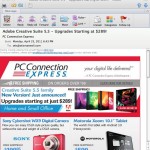Like many Netflix subscribers, I had a notice of a 60% subscription price increase slipped under my door last week in the form of an impersonal email that states the bare facts with zero attempt to placate me or to win me over if I am considering canceling after the increase. (The email concludes with “We realize you have many choices for home entertainment, and we thank you for your business. As always, if you have questions, please feel free to call us at 1-888-357-1516.” Hardly the best choice for a closing or conversion message.)
This increase is not for traditional Netflix subscribers who get a disk in the mail; it’s for the potentially far greater universe of prospects who came in via streaming. I signed up for streaming Netflix after my family got a Roku last holiday season. We quickly discovered that the “20,000 streaming movies” was actually not that big a number when looking for a specific title so we added the option of getting a disk when we can’t get instant satisfaction for $2 more a month. Nothing about our behavior, therefore, suggests we will be good candidates for conversion to a standard $7.99 a month disk in the mail plan (that’s the basis of the cost increase) and we are indeed cancelling our non-streaming subscription.
But meanwhile, Netflix is paring its streaming offerings presumably so it can get more disk orders. I know this because my teenager wanted to watch Zombieland for the umpteenth time last night and it’s gone! Not fair, Netflix! This is the company that always contacts me to ask about the video quality of the streaming show I watched or the delivery date of my DVD and a back door change in our agreement definitely doesn’t cut it. It feels like Netflix has made a corporate decision to move away from streaming and toward DVD delivery when everything we read about broadband consumption patterns should point them in the opposite direction.
Maybe, with negotiations going on behind the scenes with entertainment content providers, the streaming model isn’t making sense financially with unlimited viewings for one price. I would be willing to pay a small upcharge (NOT the full cost of renting a single DVD in the mall) for streaming access to new releases. I would also consider a “premium” level (let’s say $12.99 a month which is $5 more than the current streaming plan) for unlimited access for many more titles. But please, Netflix, don’t ask me to change my viewing habits to accommodate your new business model… even if it’s the old business model for many of your customers. I don’t think I’m alone in this. When I want to see it, I want it now… waiting for a disk in the mail seems forever.




